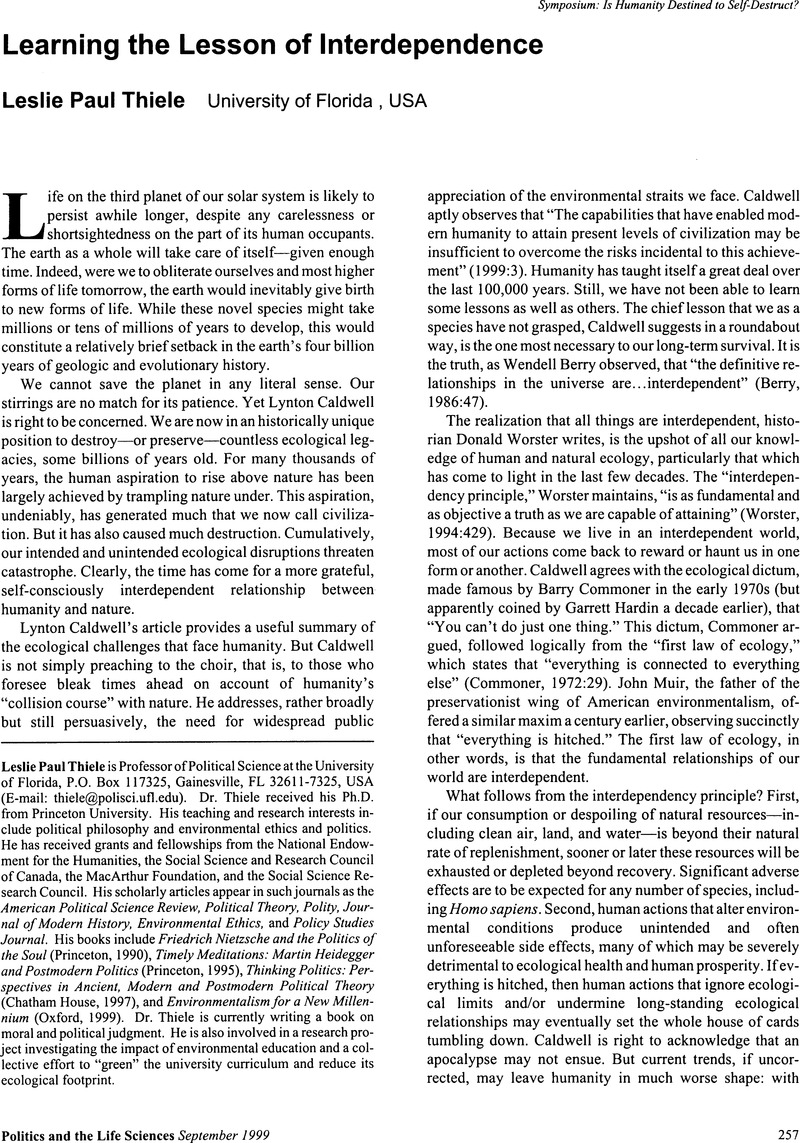No CrossRef data available.
Article contents
Learning the Lesson of Interdependence
Published online by Cambridge University Press: 17 May 2016
Abstract
An abstract is not available for this content so a preview has been provided. Please use the Get access link above for information on how to access this content.

- Type
- Symposium: Humanity and Self-Destruction
- Information
- Copyright
- Copyright © Association for Politics and the Life Sciences
References
Allen, F. and Sekscienski, G. (1992). “Greening at the Grassroots: What Polls Say about Americans' Environmental Commitment.” EPA Journal 18 (4): 52–53.Google Scholar
Berry, W. (1986). The Unsettling of America: Culture and Agriculture. San Francisco, CA: Sierra Club.Google Scholar
Bowers, C.A. (1995). Educating for an Ecologically Sustainable Culture. Albany, NY: State University of New York Press.Google Scholar
Caldwell, L.K. (1999). “Is Humanity Destined to Self-Destruct?” Politics and the Life Sciences 18: 3–14.Google Scholar
Elliott, J. (1994). “Developing Community-Focused Environmental Education through Action-Research.” In Evaluating Innovation in Environmental Education. Paris: Organization for Economic Co-operation and Development.Google Scholar
Finger, M. (1994). “From Knowledge to Action? Exploring the Relationships between Environmental Experiences, Learning, and Behavior.” Journal of Social Issues 50 (3): 141–60.Google Scholar
Gundersen, A.G. (1995). The Environmental Promise of Democratic Deliberation. Madison, Wl: University of Wisconsin Press.Google Scholar
Hungerford, H.R. and Volk, T.L. (1990). “Changing Learner Behavior through Environmental Education.” Journal of Environmental Education 21 (3): 8–21.Google Scholar
Kempton, W., Boster, J., and Hartley, J. (1995). Environmental Values in American Culture. Cambridge, MA: MIT Press.Google Scholar
Orr, D.W. (1994). Earth in Mind: On Education, Environment, and the Human Prospect. Washington, DC: Island Press.Google Scholar
Scott, D. and Willets, F.K. (1994). “Environmental Attitudes and Behavior.” Environment and Behavior 26 (2): 255.Google Scholar
Sia, A.P., Hungerford, H.R., and Tomera, A.N. (1985/1986). “Selected Predictors of Environmentally Responsible Behavior: An Analysis.” Journal of Environmental Education 17 (2): 31–40.Google Scholar
Worster, D. (1994). Nature's Economy: A History of Ecological Ideas. Cambridge: Cambridge University Press.Google Scholar
Zimmerman, L.K. (1996). “Knowledge, Affect, and the Environment: 15 Years of Research (1979–1993).” Journal of Environmental Education 27 (3): 41, 44.Google Scholar




